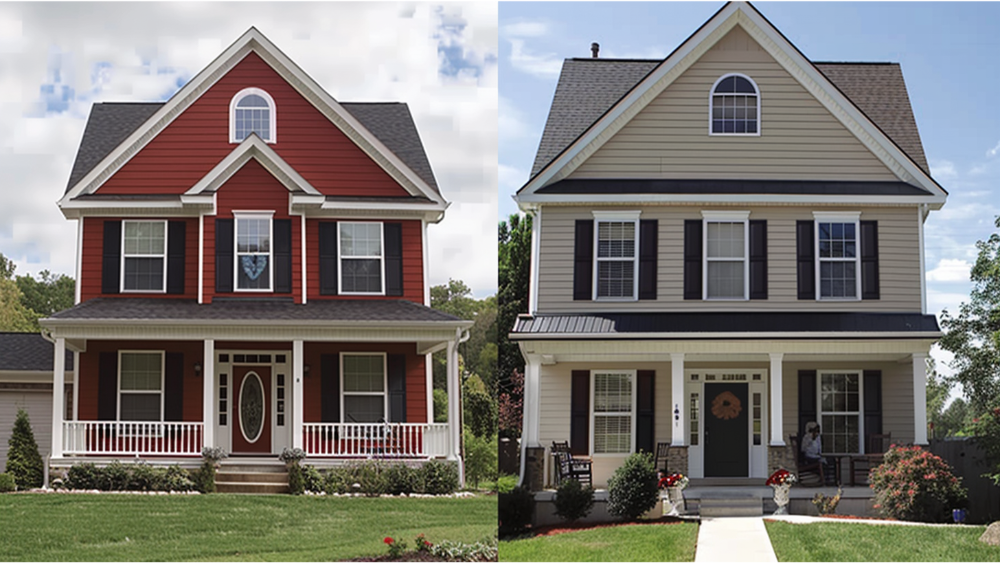Do I Want Insulated Sidi...
- Mon to Fri: 09:00 am to 07:00 pm

There are many different types and styles of siding that you can use for your home. There is stone veneer siding, aluminum siding, and also cedar shake shingles. But here we’ll be breaking down which is better fiber cement siding or vinyl siding.
Fiber cement siding and vinyl siding are two popular options for homeowners looking to upgrade the exterior of their homes. Both materials have distinct advantages and disadvantages, making them suitable for different situations. Let’s continue on so that you can make an informed decision on which is best for your home.
Fiber cement siding is a type of building material made from a combination of sand, Portland cement, water, and cellulose fibers. It was first introduced in the early 1900s as an alternative to traditional wood siding and has gained popularity in recent years due to its durability and low maintenance requirements. A well-known brand of fiber cement siding is Hardie Board siding, which is renowned for its strength and aesthetic appeal, and here at Pro Superior Construction we’re a certified partner of James Hardie, here to help in any way possible.
Standard vinyl siding, on the other hand, is a type of plastic exterior cladding made primarily from PVC (polyvinyl chloride) resin. It was first introduced in the late 1950s and has become one of the most widely used materials for home exteriors due to its affordability and versatility.

One of the key factors to consider when choosing between fiber cement siding and vinyl siding is durability. While both siding materials can withstand harsh weather conditions, better than stucco siding, and also resist rotting, cracking, or warping, some differences should be noted.
Fiber cement board siding, similar to wood pulp, because of its wood fibers is known for its exceptional durability, with some manufacturers offering warranties of up to 50 years. It is resistant to fire, pests, and moisture, making it a great option for homes in areas prone to extreme weather or insect infestations. However, it can be susceptible to damage from impact or improper installation.
Vinyl siding, on the other hand, is also durable but may not hold up as well in extreme weather conditions. It can become brittle in very cold temperatures and may crack or warp in high heat. Additionally, vinyl siding is not fire-resistant and can melt if exposed to extreme heat sources such as a grill or fire pit. This is also dependent on if the siding is insulated siding.
When it comes to maintenance, both fiber cement siding and vinyl siding have their pros and cons.
Fiber cement siding is low maintenance, requiring only occasional cleaning with soap and water. However, it may need to be repainted every 10-15 years, depending on the climate and level of exposure to sunlight.
Vinyl siding, on the other hand, is virtually maintenance-free. It does not require painting or staining and can be easily cleaned with a hose or pressure washer. However, it may become discolored over time due to exposure to UV rays and may need to be replaced if damaged.

Cost is a crucial factor when comparing fiber cement siding to vinyl siding.
Generally, fiber cement costs tend to be more expensive upfront, with prices typically ranging from $5 to $10 per square foot for materials alone, plus an additional $2 to $5 per square foot for professional installation. This higher cost is attributed to its premium materials and the necessity of skilled labor. However, with its exceptional durability and longer lifespan—often lasting 50 years or more—it may prove to be a more cost-effective option over time.
In contrast, vinyl siding is relatively affordable, typically costing between $2 to $7 per square foot for materials, and can often be installed by DIY enthusiasts, saving on labor costs. Additionally, insulated vinyl siding can help save money on heating and cooling costs. However, regular vinyl siding may need to be replaced every 20 to 30 years, potentially leading to higher long-term expenses.
Ultimately, the total cost can vary significantly based on factors such as location, the specific types of materials chosen, and installation requirements, so it’s essential to get local estimates for a more accurate picture.
Both fiber cement siding and vinyl siding come in a variety of colors and styles, allowing homeowners to achieve their desired aesthetic.
Fiber cement siding can mimic the look of wood or masonry while offering superior durability, making it a popular choice for those seeking a classic yet resilient finish. It can also be painted in any color desired, providing versatility for personal expression and home design.
Vinyl siding offers a wider range of color options and can also mimic the appearance of wood or other materials. However, some may find it less visually appealing due to its plastic appearance, which can detract from the overall charm of the home. Additionally, advancements in vinyl technology have led to versions that look more realistic and textured, bridging the gap between appearance and affordability.
Ultimately, the choice between fiber cement and vinyl siding will depend on the homeowner’s preferences, budget, and the overall style they wish to achieve for their property, ensuring that both options can enhance curb appeal in their unique ways.

Finally, it’s important to consider the environmental impact of each siding option. Fiber cement siding is made from natural materials and is considered more eco-friendly than vinyl siding, which is made from PVC resin. It offers better durability and can withstand harsh weather conditions, reducing the need for frequent replacements.
However, both materials require energy-intensive manufacturing processes and do not biodegrade easily, leading to potential waste issues at the end of their lifecycle. Additionally, sourcing and transportation of these materials contribute to their overall carbon footprint.
Therefore, when choosing siding, it’s crucial to weigh not only the aesthetics and cost but also the long-term environmental implications of your choice. Opting for sustainable practices, such as choosing locally sourced materials or manufacturers with eco-friendly processes, can further mitigate the environmental impact.

While both fiber cement siding and vinyl siding offer a wide range of colors and styles, some unique design ideas can be achieved with each material. Here are some examples to inspire homeowners looking to revamp their home’s exterior:
No matter which material you choose, there are countless possibilities for achieving your desired style and enhancing the curb appeal of your home. Don’t be afraid to mix and match siding styles or incorporate different colors to create a unique and personalized look that reflects your taste and personality.
While both fiber cement and vinyl siding have their advantages and disadvantages, it’s essential to weigh them against your specific needs and priorities. Consulting with a reputable and experienced contractor can also help you make a well-informed decision.

Why Choose Pro Superior Construction for Your Siding Needs?
At Pro Superior Construction, we pride ourselves on our in-depth knowledge and expertise in both fiber cement siding and vinyl siding. With years of experience in the industry, our team is well-versed in the benefits and drawbacks of each material, allowing us to guide homeowners in making the most informed decisions for their specific needs.
We offer comprehensive consultations to discuss your vision, budget, and any concerns you may have about siding options. Our commitment to excellence extends beyond consultation; we also provide professional installation services to ensure that your siding is applied correctly and efficiently. We believe that quality workmanship is essential for the longevity and performance of your home’s exterior.
When you choose Pro Superior Construction, you’re not just opting for superior materials; you’re choosing a partner dedicated to transforming your home’s exterior with precision and care. Contact us today to learn more about how we can assist you with all your siding needs!

Both fiber cement siding and vinyl siding are considered durable materials, but fiber cement siding is generally known for its exceptional durability and longevity. Fiber cement siding is resistant to harsh weather conditions, pests, and fire, making it a popular choice for homeowners seeking long-term protection. It can last up to 50 years or more with proper maintenance.
On the other hand, while vinyl siding is also durable and can withstand the elements, it may not hold up as well in extreme temperatures and can be prone to fading or cracking over time. Ultimately, choosing the right siding depends on your specific needs, climate, and budget, but if durability is the top priority, fiber cement siding often stands out as the superior option.
To install vinyl siding can be relatively easy to install for DIY enthusiasts, but for fiber cement siding, it’s recommended to hire a professional for optimal results. At Pro Superior Construction, we specialize in exceptional installations that ensure your siding is installed correctly and efficiently.
Our experienced team will guide you through the process, providing quality workmanship that enhances the beauty and durability of your home. Trust us to handle your siding installation with expertise!
Both fiber cement siding and vinyl siding require energy-intensive manufacturing processes and do not biodegrade easily, raising significant environmental concerns for both options. While vinyl siding is known for its durability and low maintenance, it is derived from petroleum-based products, contributing to fossil fuel consumption and pollution. On the other hand, fiber cement siding is made from a blend of natural materials, including cement, sand, and cellulose fibers, which some may consider more eco-friendly.
Additionally, fiber cement has a longer lifespan and is resistant to pests, which can reduce the frequency of replacement and waste over time. Consumers need to weigh the environmental impacts of production, longevity, and disposal when choosing between these materials. Considering sustainable options and manufacturers who prioritize eco-friendly practices can also make a significant difference in your overall environmental footprint.

When choosing between fiber cement siding and vinyl siding for your home, it’s crucial to consider several key factors. Both materials have unique benefits and drawbacks, leading to a decision based on personal preference, budget, and specific needs.
Fiber cement siding is known for its durability and longevity, making it a solid investment for resisting pests, rot, and fire. It comes in various styles and colors to match your aesthetic. In contrast, vinyl siding is more budget-friendly and easier to install, making it a popular choice for those seeking a quick, economical solution. It requires minimal maintenance and is available in many colors and finishes, though it may not be as durable as fiber cement.
At Pro Superior Construction, we have extensive experience with both types of siding. Our team offers expert guidance tailored to your needs, ensuring you select the right material for your home. We also provide professional installation services to maximize the benefits of your siding.
If you’re considering a siding upgrade or replacement, weigh your options carefully and consult with professionals for the best results. With the right materials and proper installation, you can significantly enhance your home’s curb appeal and value. Trust Pro Superior Construction to help turn your vision into reality!
Contact us today to schedule your consultation! We look forward to partnering with you to transform your home’s exterior.

by Dan Dryer
July 26, 2024